Art World
Think You Know ‘David’? Here Are 3 Surprising Facts About Michelangelo’s Masterpiece
There's a long and storied history associated with the famous sculpture.
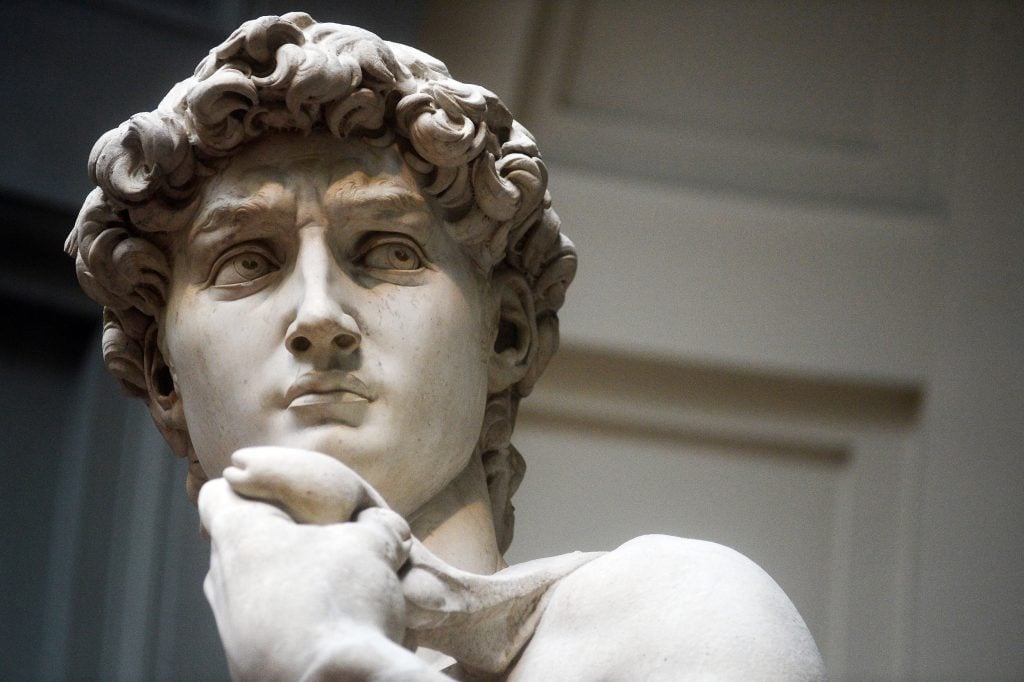
Towering at over 16 feet tall and weighing in at more than 12,000 pounds, Michelangelo’s marble David is colossal yet still the eternal underdog. Ready to strike a Goliath somewhere off in the distance, a nude and vulnerable David is armed only with the sling that he clutches in his right hand—and his inherent grit. While most Renaissance images of this Old Testament figure show him after his unlikely victory, here he’s depicted at the charged moment before he meets his mightier opponent and when everything is still uncertain.
A 26-year-old Michelangelo was commissioned to create this sculpture for the roofline of the Florence cathedral in the summer of 1501. But when he completed David, a panel of leading artists (including da Vinci, Botticelli, Perugino, and Filippino Lippi) decided to place it at the entrance to the Palazzo Vecchio, the Florentine town hall, where it was unveiled in September 1504. Intended as a religious figure, David instead became a civic one—symbolizing Florentine values of liberty and political freedom against giants such as Milan and Naples. David changed functions once again in 1873, when he was removed from the Piazza della Signoria for preservation reasons and installed at the Galleria dell’Accademia as an art object. (A replica stands in place of the original near the Palazzo Vecchio but don’t be fooled, the real Michelangelo is in the art gallery.)
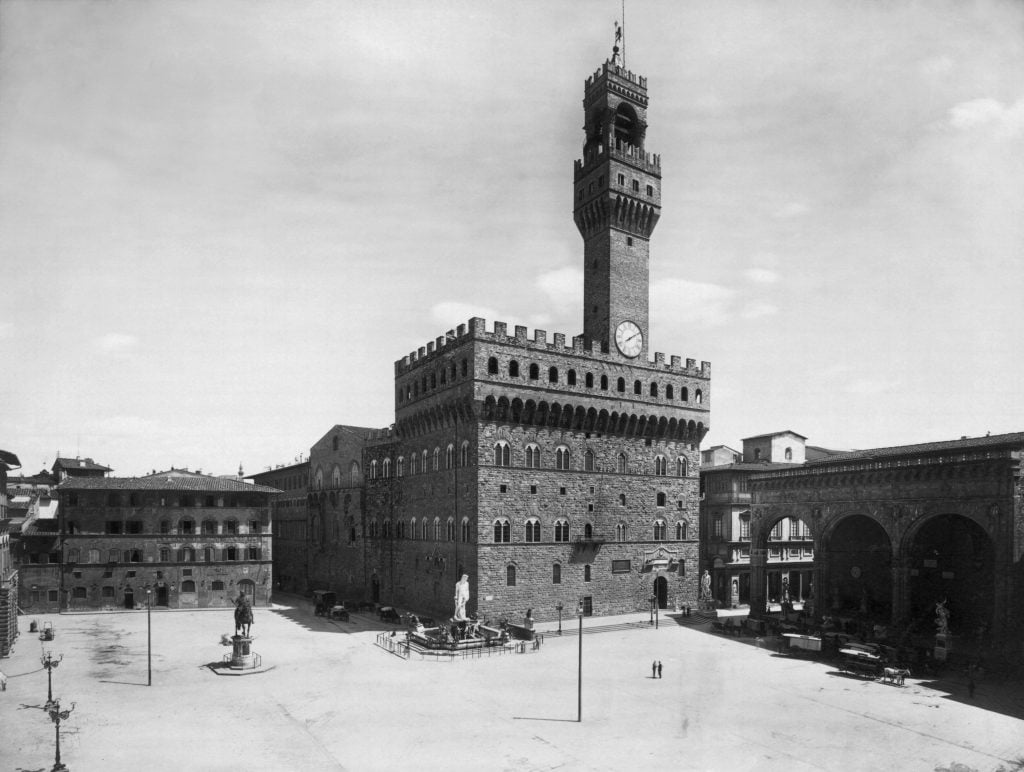
General view of the Palazzo Vecchio and the plaza before the palace in Florence (Firenze). In the courtyard before the palace stands Michelangelo’s statue David (1501-1504), now found in the Accademia in Florence. Undated photograph, courtesy of Getty Images.
“To be sure, anyone who sees this statue need not be concerned with seeing any other piece of sculpture done in our times or in any other period by any other artist,” boasted Renaissance art historian Giorgio Vasari, in his Lives of the Most Excellent Painters, Sculptors, and Architects (1550). Here are three things you may not know about this unmissable Michelangelo masterpiece.
Michelangelo Used Hand-Me-Down Marble

People look at the original 16th century statue of David by Italian artist Michelangelo Buonarroti in the Galleria dell’Accademia in Florence. Photo: Gabriel Bouys/AFP via Getty Images.
Michelangelo, who considered himself more of a sculptor than a painter, was a diva when it came to selecting raw material. He often chose his marble in person, on site in Carrara and Pietrasanta, giving exact instructions about size, shape, and even what roads to use for transport. He maintained contracts with specific cavatori (marble excavators), scarpellini (quarry cutters), and squadratori (block squarers)—using vetted craftsmen.
But for David, arguably his most famous sculpture? Michelangelo used a hand-me-down block of marble with imperfections that two artists had already tried using and given up on, and which had subsequently been left in a courtyard for a couple decades.
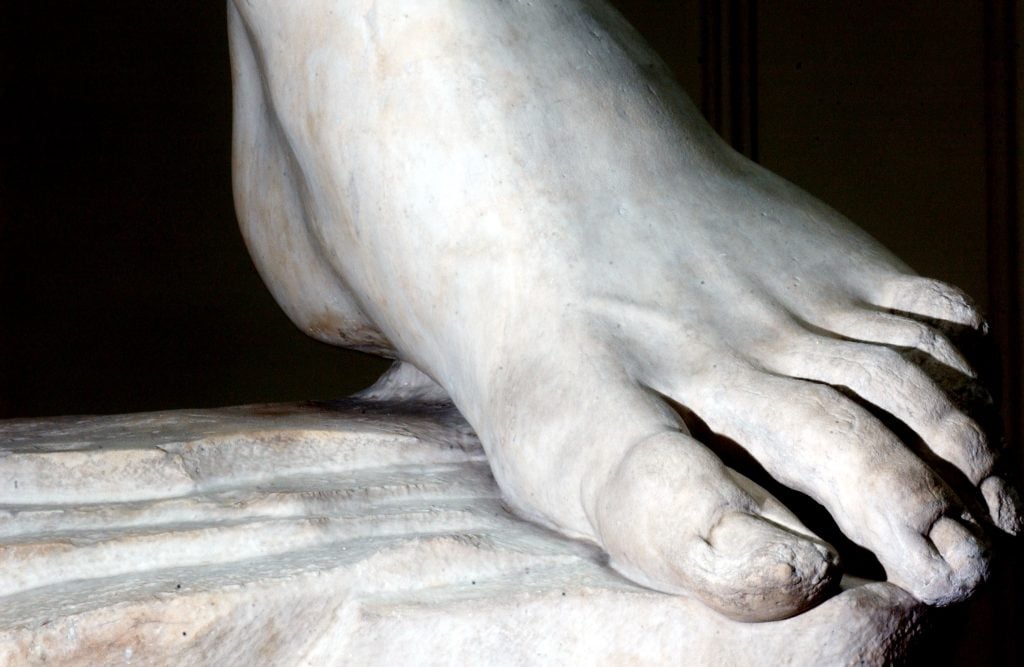
A close-up of the foot of Michelangelo’s masterpiece David after restoration was completed May 24, 2004 at the Galleria dell’Accademia in Florence, Italy. Photo by Franco Origlia/Getty Images.
Agostino di Duccio first tried using it in 1464 and partially blocked out the legs before quitting for unclear reasons; Antonio Rossellino was commissioned to use it in 1475 but didn’t begin carving because he said the marble was of poor quality. (Rossellino’s assessment wasn’t off—samples from one of David’s toes were studied in 2005, allowing scientists to track the block to the Fantiscritti quarries in central Carrara and confirm that it’s riddled with microscopic holes that make it susceptible to faster degradation.)
The marble’s pre-existing proportions may have impacted the sculpture’s design, explaining why David is leaner than most Michelangelo sculptures. “It would be difficult to carve an entire figure out of [the block] without adding additional pieces, no other man except Michelangelo had the courage to complete it without other pieces,” wrote Vasari. “Michelangelo certainly performed a miracle in restoring to life a block of marble left for dead.”
Parts of the Sculpture Were Gilded
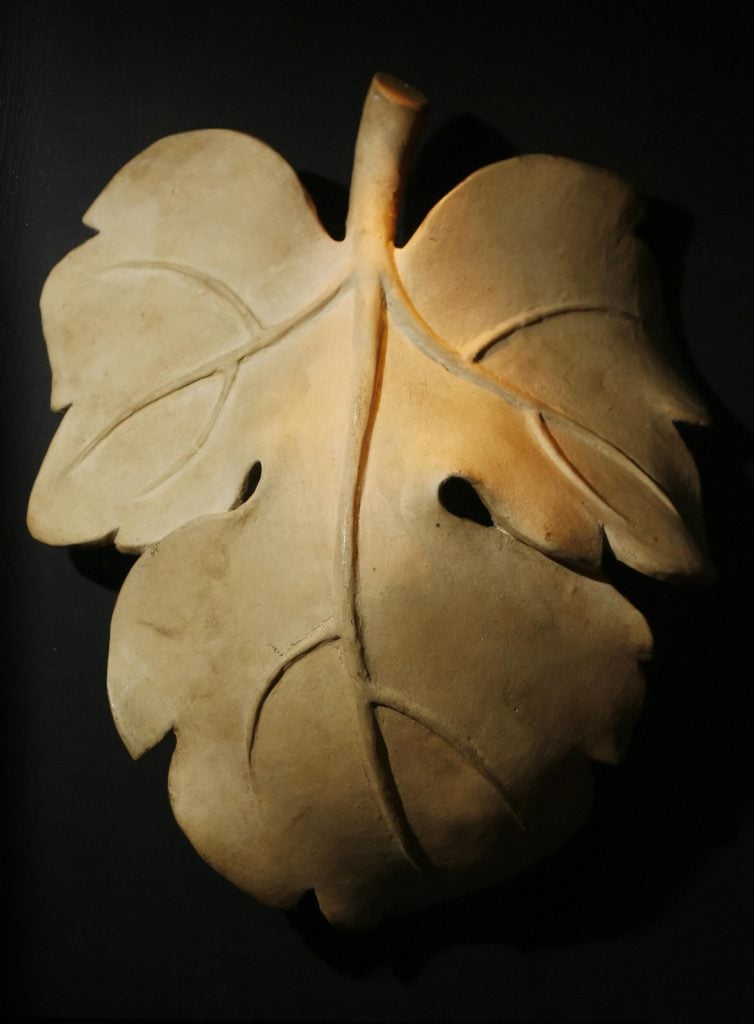
A plaster cast of a fig leaf that was made for the private parts of Michaelangelo’s David and presented by the Grand Duke of Tuscany to Queen Victoria in 1857, who apparently requested that the huge figures genitals should be hidden from the view of women and children. Photo: Leon Neal/AFP via Getty Images.
Michelangelo didn’t add additional pieces of marble to David, but he did add gilding that was lost over time. The trunk supporting the right leg, sling, and a victory garland on his head were all once gilded by the artist.
And then there were additions made by others. When David was installed near the Palazzo Vecchio, he was fully and monumentally nude, but it was a time of religious conservatism. Girolamo Savonarola, a Dominican friar with ascetic views who briefly controlled Florence, had been executed a few years before in 1498 but his opinions had lingering effects. Within a month, a metal garland with 28 leaves was commissioned for the sculpture’s genital area, and in 1508 it was replaced with a gilded one. (It’s unclear when and how David was disrobed of this golden garment.)
When David was conserved between 2002 and 2004, scientists detected rough surfaces on the tree trunk and sling that would have helped the gold adhere to the marble.
Copycats Have Been Around for Centuries
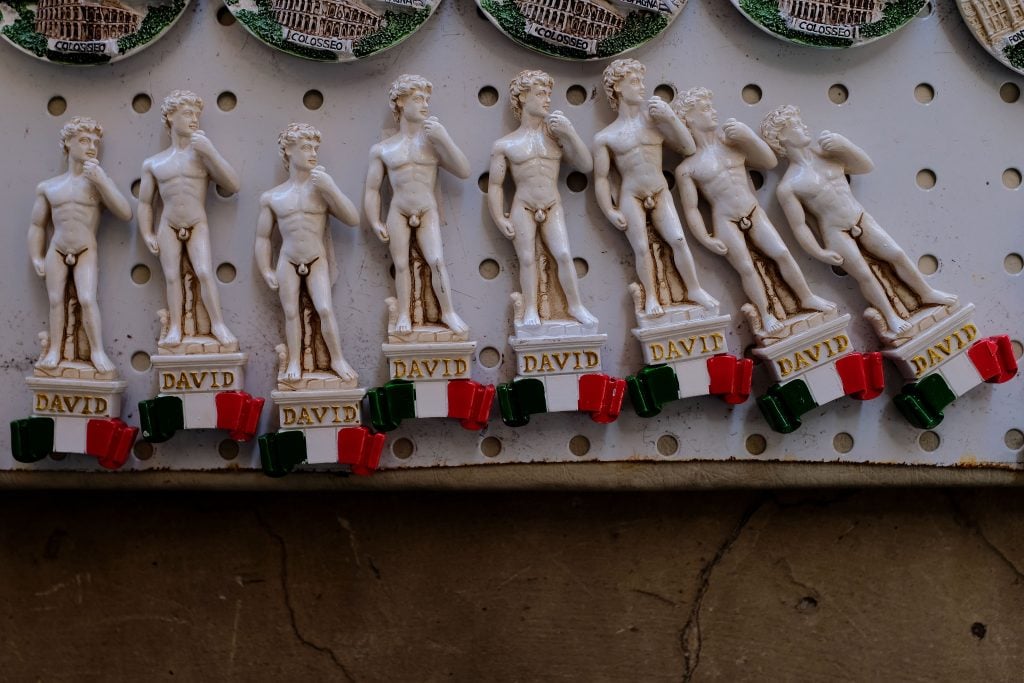
Magnets depicting Michelangelo’s famed sculpture in a souvenir shop in Rome. Photo: Alberto Pizzoli//AFP via Getty Images.
Walk around Florence and you’ll see souvenir replicas of David in all shapes and sizes (and varying degrees of good taste). Some copies are more impressive than others.
In 1847, Leopold II the Grand Duke of Tuscany commissioned an exact replica of the David in order to test alternate locations for the monumental statue (which already showed signs of degradation). A copy was made in plaster—the only complete mold of David ever made from the original. Royal cast maker Clemente Papi sealed Michelangelo’s statue with oil, wax, or soap and then began the difficult task of making over 1500 distinct mold pieces that were held in place by an outer ‘mother mold.’ (Evidence of Papi’s process was found during conservation of David in 2002, including plaster residue in tough to clean places like between his toes.)
Papi’s cast was installed in the Loggia dei Lanzi, the Accademia’s Sala del Colossus, and briefly the Bargello National Museum—each an attempt to find a better location. The Accademia di Belle Arti was ultimately chosen, and for 25 years David was packed in a box until he could be permanently installed in the purpose-built round gallery with a skylight in 1873. (Papi’s cast is on view elsewhere in Florence, at the Gipsoteca at the Istituto Statale D’Arte.)
While the marble David was waiting for his new home to be ready, in 1856 Leopold II had a full-sized plaster doppelganger made and sent to England as a gift for Queen Victoria. The Queen, in turn, gifted David to the new South Kensington Museum (present-day Victoria & Albert Museum) so that it could be enjoyed by the public. Shipped in pieces aboard The Cheshire Witch which sailed from Livorno to London, Papi accompanied the reproduction and oversaw its assembly at the museum. (The cost of transporting the faux David was higher than the cost of producing it.)
Papi’s replica didn’t include a copy of the garland once used to cover the sculpture’s genitalia, an apparent must for Queen Victoria. Soon after arriving in London, a bespoke fig leaf was commissioned to cover David during royal visits—hung by two strategically placed hooks when the Queen came to the museum and otherwise removed.





